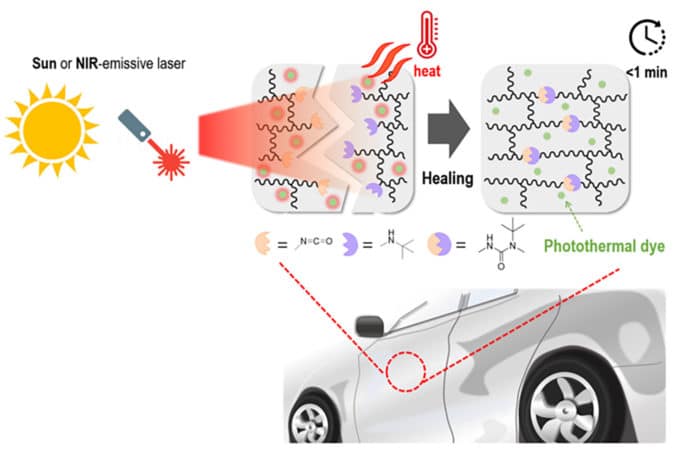The most crucial factor in safeguarding a car surface is the excellent durability of automotive coatings. Protective coating materials should also be transparent and colorless to preserve the product’s natural color.
However, it isn’t easy to provide a self-healing function while satisfying all of these conditions. Existing commercially available materials have some limitations. Materials with high self-healing efficiency have low durability, whereas materials with high hardness and excellent durability have remarkably poor self-healing performance.
In a new study, Dr. Jin Chul Kim, Dr. Young il Park, and Dr. Ji-Eun Jeong of the Korea Research Institute of Chemical Technology (KRICT) have developed a transparent coating material that satisfies all of the above conditions and has similar performance to that of commercial protective coating materials. An interesting fact is the material can self-heal within 30 mins when exposed to sunlight (Particularly near-infrared light sunlight, in the wavelength range of 1,000 to 1,100 nm).
To demonstrate the self-healing performance, scientists coated a laboratory-scale model car using a spray-coating machine. When the model car was exposed to midday sunlight for about 30 minutes, the scratch completely disappeared, and the surface of the coating material was restored.
How does this self-healing phenomenon work?
The surface temperature rises when the material absorbs sunlight as light energy is converted into thermal energy. As a result, the increased surface temperature makes it possible to self-heal a surface scratch by repeating the dissociation and recombination of chemical bonds in the polymer structure.
To create this material, scientists added a dynamic chemical bond(Hindered urea structure) that can repeat the decomposition and recombination of the polymer structure. This chemical bond was then mixed with a transparent photothermal dye so that dynamic chemical bonding could occur actively upon exposure to sunlight.
Scientists especially used transparent organic photothermal dyes. These dyes can absorb near-infrared light. Also, they do not affect the product color as they are of colorless inherent color.
Dr. Jin Chul Kim from KRICT, the research director, said, “The developed technology is a platform technology that synthesizes self-healing coating materials using inexpensive commercial polymer materials and photothermal dyes. It is expected to be widely used not only in automotive clearcoats but also in various applications.”
“The developed self-healing material is expected to be used as a coating material for transportation applications, electronic devices such as smartphones and computers, and building materials in the future. In addition, it is expected to contribute to the realization of carbon neutrality by reducing the use of harmful organic solvents, which are generated in large amounts when repainting vehicles.”
Journal Reference:
- Da Hae Son et al. Fast, Localized, and Low-Energy Consumption Self-Healing of Automotive Clearcoats Using a Photothermal Effect Triggered by NIR Radiation. ACS Appl. Polym. Mater. 2022, 4, 5, 3802–3810. April 1, 2022. DOI: 10.1021/acsapm.1c01768
